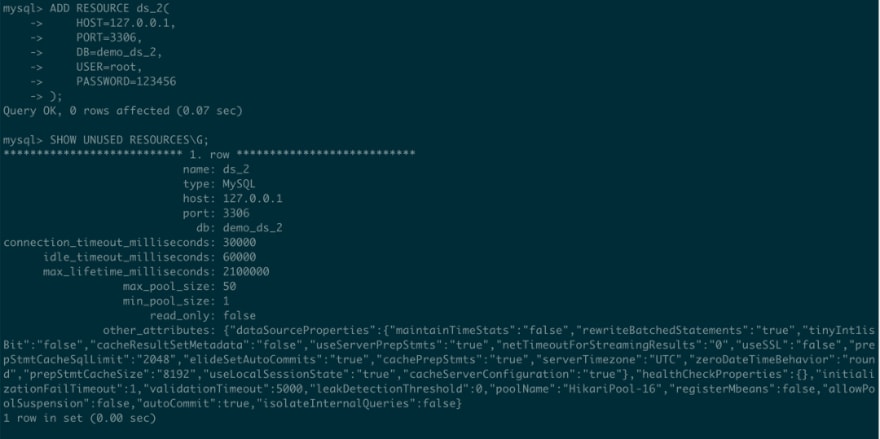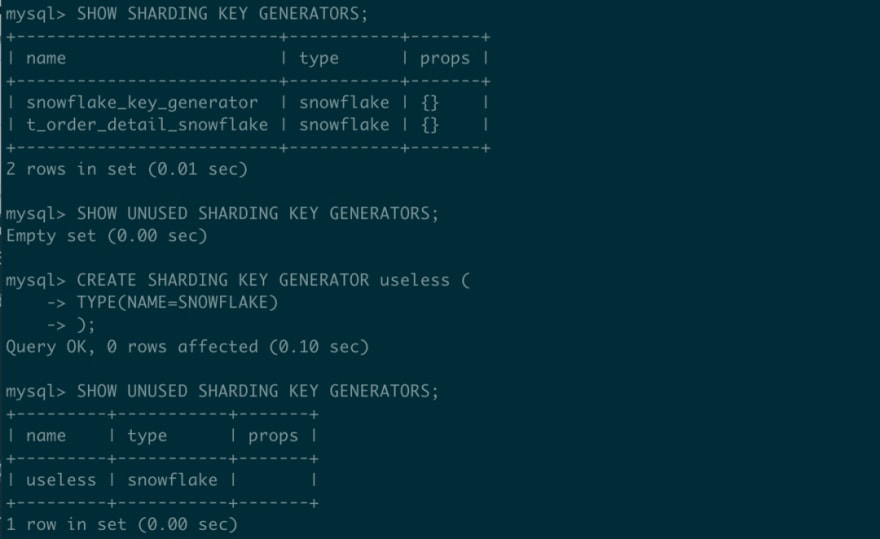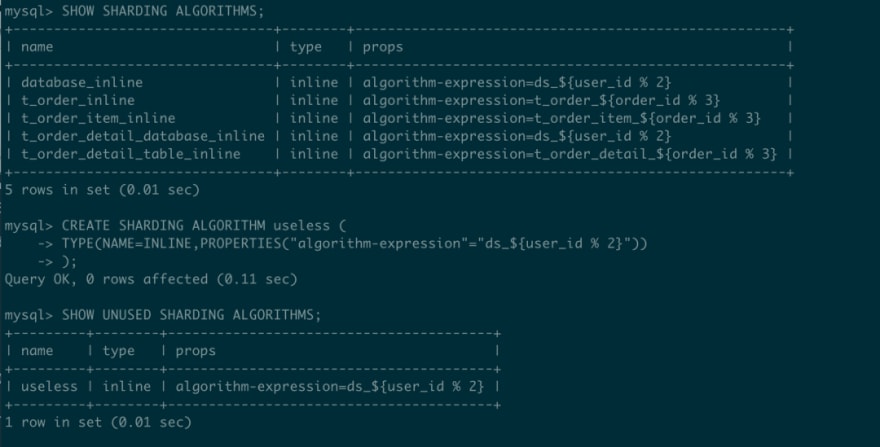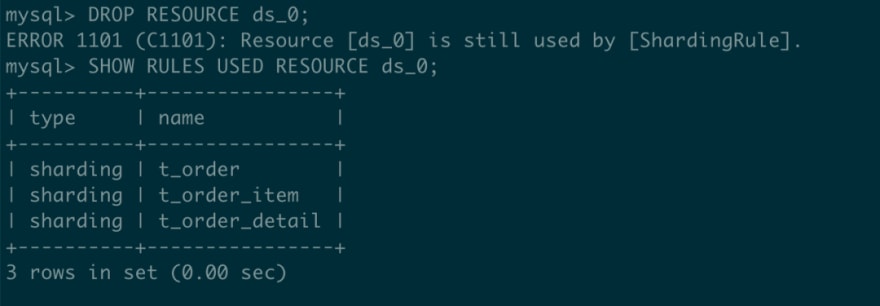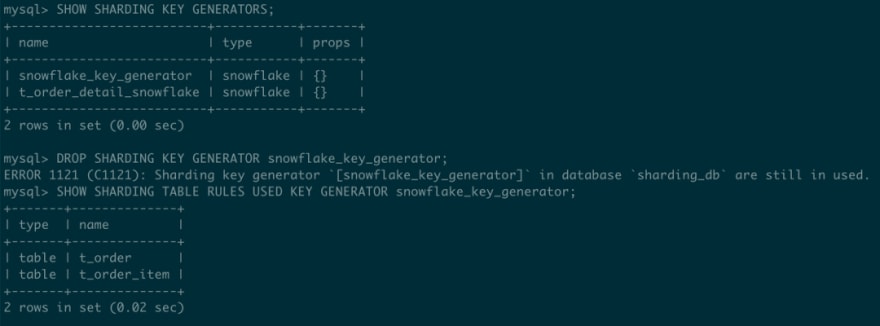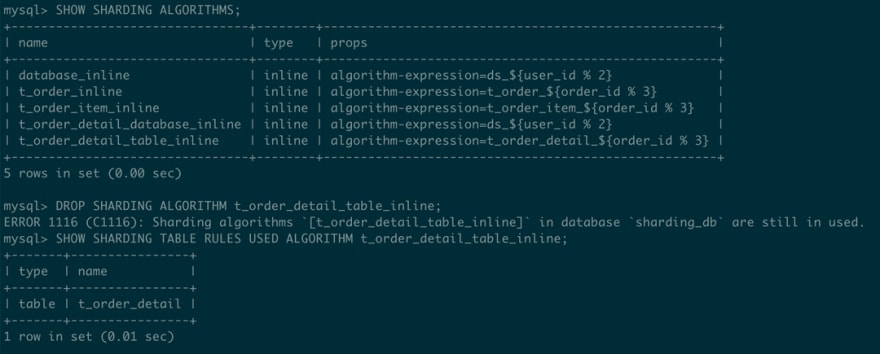An Interest In:
Web News this Week
- April 19, 2024
- April 18, 2024
- April 17, 2024
- April 16, 2024
- April 15, 2024
- April 14, 2024
- April 13, 2024
DistSQL Applications: Building a Dynamic Distributed Database
Background
Ever since the release of ShardingSphere 5.0.0, DistSQL has been providing strong dynamic management capabilities to the ShardingSphere ecosystem.
Thanks to DistSQL, users have been empowered to do the following:
- Create logical databases online.
- Dynamically configure rules (i.e. sharding, data encryption, read/write splitting, database discovery, shadow DB, and global rules).
- Adjust storage resources in real-time.
- Switch transaction types instantly.
- Turn SQL logs on and off at any time.
- Preview the SQL routing results.At the same time, in the context of increasingly diversified scenarios, more and more DistSQL features are being created and a variety of valuable syntaxes have been gaining popularity among users.
Overview
This post takes data sharding as an example to illustrate DistSQLs application scenarios and related sharding methods.
A series of DistSQL statements are concatenated through practical cases, to give you a complete set of practical DistSQL sharding management schemes, which create and maintain distributed databases through dynamic management. The following DistSQL will be used in this example: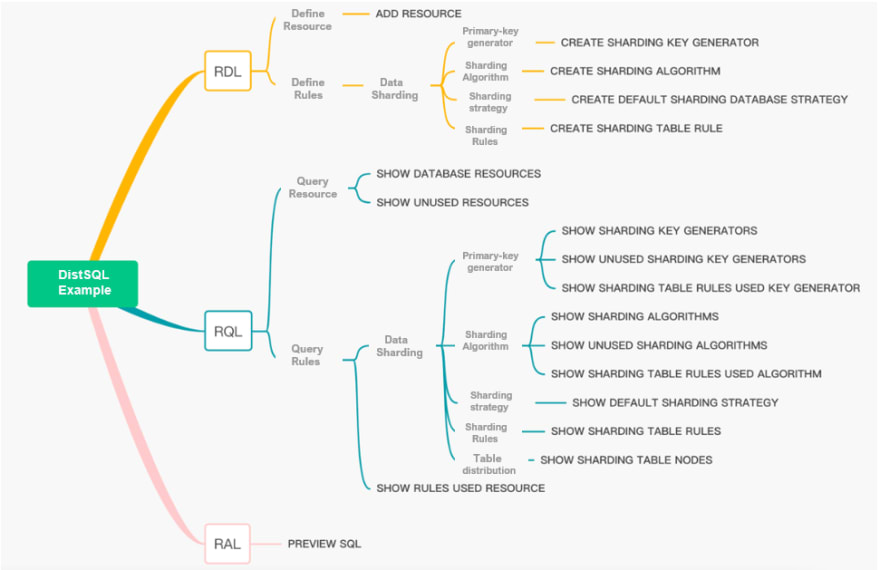
Practical Case
Required scenarios
- Create two sharding tables:
t_orderandt_order_item. - For both tables, database shards are carried out with the
user_idfield, and table shards with theorder_idfield. - The number of shards is 2 databases * 3 tables.As shown in the figure below:
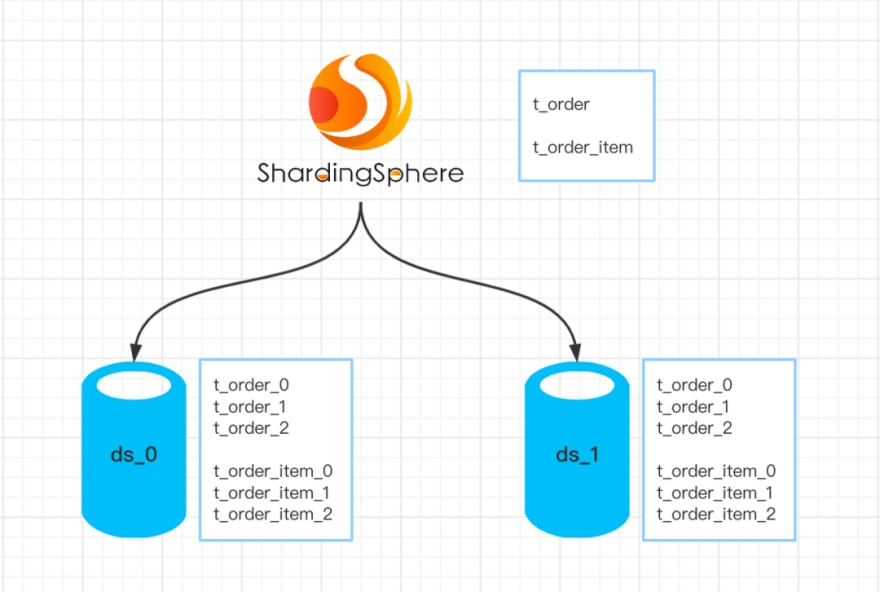
Setting up the environment
1.Prepare a MySQL database instance for access. Create two new databases: demo_ds_0 and demo_ds_1.
Here we take MySQL as an example, but you can also use PostgreSQL or openGauss databases.
2.Deploy Apache ShardingSphere-Proxy 5.1.2 and Apache ZooKeeper. ZooKeeper acts as a governance center and stores ShardingSphere metadata information.
3.Configure server.yaml in the Proxy conf directory as follows:
mode: type: Cluster repository: type: ZooKeeper props: namespace: governance_ds server-lists: localhost:2181 # ZooKeeper address retryIntervalMilliseconds: 500 timeToLiveSeconds: 60 maxRetries: 3 operationTimeoutMilliseconds: 500 overwrite: falserules: - !AUTHORITY users: - root@%:root4.Start ShardingSphere-Proxy and connect it to Proxy using a client, for example:
mysql -h 127.0.0.1 -P 3307 -u root -pCreating a distributed database
CREATE DATABASE sharding_db;USE sharding_db;Adding storage resources
1.Add storage resources corresponding to the prepared MySQL database.
ADD RESOURCE ds_0 ( HOST=127.0.0.1, PORT=3306, DB=demo_ds_0, USER=root, PASSWORD=123456), ds_1( HOST=127.0.0.1, PORT=3306, DB=demo_ds_1, USER=root, PASSWORD=123456);2.View storage resources
mysql> SHOW DATABASE RESOURCES\G;*************************** 1. row *************************** name: ds_1 type: MySQL host: 127.0.0.1 port: 3306 db: demo_ds_1 -- Omit partial attributes*************************** 2. row *************************** name: ds_0 type: MySQL host: 127.0.0.1 port: 3306 db: demo_ds_0 -- Omit partial attributesAdding \G to the query statement aims to make the output format more readable, and it is not a must.
Creating sharding rules
ShardingSpheres sharding rules support regular sharding and automatic sharding. Both sharding methods have the same effect. The difference is that the configuration of automatic sharding is more concise, while regular sharding is more flexible and independent.
Please refer to the following links for more details on automatic sharding:
Intro to DistSQL-An Open Source and More Powerful SQL
AutoTable: Your Butler-Like Sharding Configuration Tool
Next, well adopt regular sharding and use the INLINE expression algorithm to implement the sharding scenarios described in the requirements.
Primary key generator
The primary key generator can generate a secure and unique primary key for a data table in a distributed scenario. For details, refer to the document Distributed Primary Key.
1.Create the primary key generator.
CREATE SHARDING KEY GENERATOR snowflake_key_generator (TYPE(NAME=SNOWFLAKE));2.Query primary key generator
mysql> SHOW SHARDING KEY GENERATORS;+-------------------------+-----------+-------+| name | type | props |+-------------------------+-----------+-------+| snowflake_key_generator | snowflake | {} |+-------------------------+-----------+-------+1 row in set (0.01 sec)Sharding algorithm
1.Create a database sharding algorithm, used by t_order and t_order_item in common.
-- Modulo 2 based on user_id in database shardingCREATE SHARDING ALGORITHM database_inline (TYPE(NAME=INLINE,PROPERTIES("algorithm-expression"="ds_${user_id % 2}")));2.Create different table shards algorithms for t_order and t_order_item.
-- Modulo 3 based on order_id in table shardingCREATE SHARDING ALGORITHM t_order_inline (TYPE(NAME=INLINE,PROPERTIES("algorithm-expression"="t_order_${order_id % 3}")));CREATE SHARDING ALGORITHM t_order_item_inline (TYPE(NAME=INLINE,PROPERTIES("algorithm-expression"="t_order_item_${order_id % 3}")));3.Query sharding algorithm
mysql> SHOW SHARDING ALGORITHMS;+---------------------+--------+---------------------------------------------------+| name | type | props |+---------------------+--------+---------------------------------------------------+| database_inline | inline | algorithm-expression=ds_${user_id % 2} || t_order_inline | inline | algorithm-expression=t_order_${order_id % 3} || t_order_item_inline | inline | algorithm-expression=t_order_item_${order_id % 3} |+---------------------+--------+---------------------------------------------------+3 rows in set (0.00 sec)Default sharding strategy
Sharding strategy consists of sharding key and sharding algorithm. Please refer to Sharding Strategy for its concept.
Sharding strategy consists of databaseStrategy and tableStrategy.
Since t_order and t_order_item have the same database sharding field and sharding algorithm, we create a default strategy that will be used by all shard tables with no sharding strategy configured:
1.Create a default database sharding strategy
CREATE DEFAULT SHARDING DATABASE STRATEGY (TYPE=STANDARD,SHARDING_COLUMN=user_id,SHARDING_ALGORITHM=database_inline);2.Query default strategy
mysql> SHOW DEFAULT SHARDING STRATEGY\G;*************************** 1. row *************************** name: TABLE type: NONE sharding_column: sharding_algorithm_name: sharding_algorithm_type:sharding_algorithm_props:*************************** 2. row *************************** name: DATABASE type: STANDARD sharding_column: user_id sharding_algorithm_name: database_inline sharding_algorithm_type: inlinesharding_algorithm_props: {algorithm-expression=ds_${user_id % 2}}2 rows in set (0.00 sec)The default table sharding strategy is not configured, so the default strategy of
TABLEisNONE.
Sharding rules
The primary key generator and sharding algorithm are both ready. Now create sharding rules.
1.t_order
CREATE SHARDING TABLE RULE t_order (DATANODES("ds_${0..1}.t_order_${0..2}"),TABLE_STRATEGY(TYPE=STANDARD,SHARDING_COLUMN=order_id,SHARDING_ALGORITHM=t_order_inline),KEY_GENERATE_STRATEGY(COLUMN=order_id,KEY_GENERATOR=snowflake_key_generator));
DATANODESspecifies the data nodes of shard tables.TABLE_STRATEGYspecifies the table strategy, among whichSHARDING_ALGORITHMuses created sharding algorithmt_order_inline;KEY_GENERATE_STRATEGYspecifies the primary key generation strategy of the table. Skip this configuration if primary key generation is not required.
2.t_order_item
CREATE SHARDING TABLE RULE t_order_item (DATANODES("ds_${0..1}.t_order_item_${0..2}"),TABLE_STRATEGY(TYPE=STANDARD,SHARDING_COLUMN=order_id,SHARDING_ALGORITHM=t_order_item_inline),KEY_GENERATE_STRATEGY(COLUMN=order_item_id,KEY_GENERATOR=snowflake_key_generator));3.Query sharding rules
mysql> SHOW SHARDING TABLE RULES\G;*************************** 1. row *************************** table: t_order actual_data_nodes: ds_${0..1}.t_order_${0..2} actual_data_sources: database_strategy_type: STANDARD database_sharding_column: user_id database_sharding_algorithm_type: inlinedatabase_sharding_algorithm_props: algorithm-expression=ds_${user_id % 2} table_strategy_type: STANDARD table_sharding_column: order_id table_sharding_algorithm_type: inline table_sharding_algorithm_props: algorithm-expression=t_order_${order_id % 3} key_generate_column: order_id key_generator_type: snowflake key_generator_props:*************************** 2. row *************************** table: t_order_item actual_data_nodes: ds_${0..1}.t_order_item_${0..2} actual_data_sources: database_strategy_type: STANDARD database_sharding_column: user_id database_sharding_algorithm_type: inlinedatabase_sharding_algorithm_props: algorithm-expression=ds_${user_id % 2} table_strategy_type: STANDARD table_sharding_column: order_id table_sharding_algorithm_type: inline table_sharding_algorithm_props: algorithm-expression=t_order_item_${order_id % 3} key_generate_column: order_item_id key_generator_type: snowflake key_generator_props:2 rows in set (0.00 sec)So far, the sharding rules for t_order and t_order_item have been configured.
A bit complicated? Well, you can also skip the steps of creating the primary key generator, sharding algorithm, and default strategy, and complete the sharding rules in one step. Let's see how to make it easier.
Syntax
Now, if we have to add a shard table t_order_detail, we can create sharding rules as follows:
CREATE SHARDING TABLE RULE t_order_detail (DATANODES("ds_${0..1}.t_order_detail_${0..1}"),DATABASE_STRATEGY(TYPE=STANDARD,SHARDING_COLUMN=user_id,SHARDING_ALGORITHM(TYPE(NAME=INLINE,PROPERTIES("algorithm-expression"="ds_${user_id % 2}")))),TABLE_STRATEGY(TYPE=STANDARD,SHARDING_COLUMN=order_id,SHARDING_ALGORITHM(TYPE(NAME=INLINE,PROPERTIES("algorithm-expression"="t_order_detail_${order_id % 3}")))),KEY_GENERATE_STRATEGY(COLUMN=detail_id,TYPE(NAME=snowflake)));**Note: **The above statement specified database sharding strategy, table strategy, and primary key generation strategy, but it didnt use existing algorithms.
Therefore, the DistSQL engine automatically uses the input expression to create an algorithm for the sharding rules of t_order_detail. Now the primary key generator, sharding algorithm, and sharding rules are as follows:
1.Primary key generator
mysql> SHOW SHARDING KEY GENERATORS;+--------------------------+-----------+-------+| name | type | props |+--------------------------+-----------+-------+| snowflake_key_generator | snowflake | {} || t_order_detail_snowflake | snowflake | {} |+--------------------------+-----------+-------+2 rows in set (0.00 sec)2.Sharding algorithm
mysql> SHOW SHARDING ALGORITHMS;+--------------------------------+--------+-----------------------------------------------------+| name | type | props |+--------------------------------+--------+-----------------------------------------------------+| database_inline | inline | algorithm-expression=ds_${user_id % 2} || t_order_inline | inline | algorithm-expression=t_order_${order_id % 3} || t_order_item_inline | inline | algorithm-expression=t_order_item_${order_id % 3} || t_order_detail_database_inline | inline | algorithm-expression=ds_${user_id % 2} || t_order_detail_table_inline | inline | algorithm-expression=t_order_detail_${order_id % 3} |+--------------------------------+--------+-----------------------------------------------------+5 rows in set (0.00 sec)3.Sharding rules
mysql> SHOW SHARDING TABLE RULES\G;*************************** 1. row *************************** table: t_order actual_data_nodes: ds_${0..1}.t_order_${0..2} actual_data_sources: database_strategy_type: STANDARD database_sharding_column: user_id database_sharding_algorithm_type: inlinedatabase_sharding_algorithm_props: algorithm-expression=ds_${user_id % 2} table_strategy_type: STANDARD table_sharding_column: order_id table_sharding_algorithm_type: inline table_sharding_algorithm_props: algorithm-expression=t_order_${order_id % 3} key_generate_column: order_id key_generator_type: snowflake key_generator_props:*************************** 2. row *************************** table: t_order_item actual_data_nodes: ds_${0..1}.t_order_item_${0..2} actual_data_sources: database_strategy_type: STANDARD database_sharding_column: user_id database_sharding_algorithm_type: inlinedatabase_sharding_algorithm_props: algorithm-expression=ds_${user_id % 2} table_strategy_type: STANDARD table_sharding_column: order_id table_sharding_algorithm_type: inline table_sharding_algorithm_props: algorithm-expression=t_order_item_${order_id % 3} key_generate_column: order_item_id key_generator_type: snowflake key_generator_props:*************************** 3. row *************************** table: t_order_detail actual_data_nodes: ds_${0..1}.t_order_detail_${0..1} actual_data_sources: database_strategy_type: STANDARD database_sharding_column: user_id database_sharding_algorithm_type: inlinedatabase_sharding_algorithm_props: algorithm-expression=ds_${user_id % 2} table_strategy_type: STANDARD table_sharding_column: order_id table_sharding_algorithm_type: inline table_sharding_algorithm_props: algorithm-expression=t_order_detail_${order_id % 3} key_generate_column: detail_id key_generator_type: snowflake key_generator_props:3 rows in set (0.01 sec)Note: In the CREATE SHARDING TABLE RULE statement, DATABASE_STRATEGY, TABLE_STRATEGY, and KEY_GENERATE_STRATEGY can all reuse existing algorithms.
Alternatively, they can be defined quickly through syntax. The difference is that additional algorithm objects are created. Users can use it flexibly based on scenarios.
After the configuration verification rules are created, you can verify them in the following ways:
Checking node distribution
DistSQL provides SHOW SHARDING TABLE NODES for checking node distribution and users can quickly learn the distribution of shard tables.
We can see the node distribution of the shard table is consistent with what is described in the requirement.
SQL Preview
Previewing SQL is also an easy way to verify configurations. Its syntax is PREVIEW SQL:
1.Query with no shard key with all routes
2.Specify user_id to query with a single database route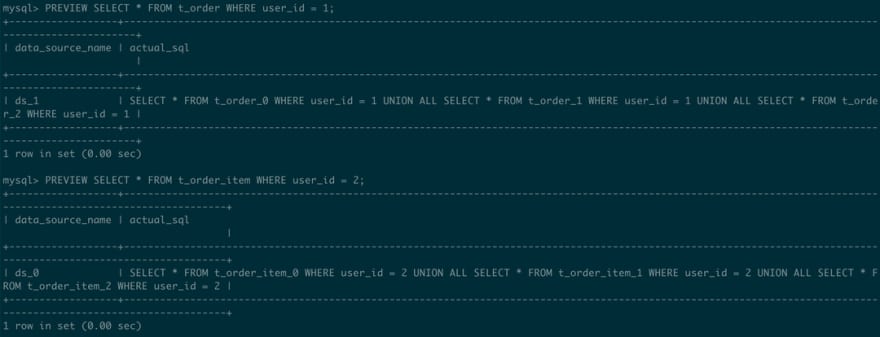
3.Specify user_id and order_id with a single table route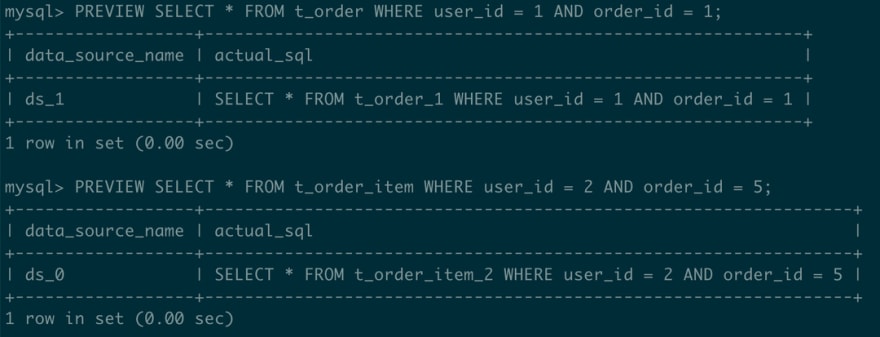
Single-table routes scan the least shard tables and offer the highest efficiency.
DistSQL auxiliary query
During the system maintenance, algorithms or storage resources that are no longer in use may need to be released, or resources that need to be released may have been referenced and cannot be deleted. The following DistSQL can solve these problems.
Query unused resources
1.Syntax: SHOW UNUSED RESOURCES
Query unused primary key generator
1.Syntax: SHOW UNUSED SHARDING KEY GENERATORS
Query unused sharding algorithm
1.Syntax: SHOW UNUSED SHARDING ALGORITHMS
Query rules that use the target storage resources
1.Syntax: SHOW RULES USED RESOURCE
All rules that use the resource can be queried, not limited to the
Sharding Rule.
Query sharding rules that use the target primary key generator
1.Syntax: SHOW SHARDING TABLE RULES USED KEY GENERATOR
Query sharding rules that use the target algorithm
1.Syntax: SHOW SHARDING TABLE RULES USED ALGORITHM
Conclusion
This post takes the data sharding scenario as an example to introduce DistSQLs applications and methods.
DistSQL provides flexible syntax to help simplify operations. In addition to the INLINE algorithm, DistSQL supports standard sharding, compound sharding, Hint sharding, and custom sharding algorithms. More examples will be covered in the coming future.
If you have any questions or suggestions about Apache ShardingSphere, please feel free to post them on the GitHub Issue list.
Project Links:
ShardingSphere Slack
Contributor Guide
References
Author
Jiang Longtao
SphereEx Middleware R&D Engineer & Apache ShardingSphere Committer.
Longtao focuses on the R&D of DistSQL and related features.
Original Link: https://dev.to/apache_shardingsphere/distsql-applications-building-a-dynamic-distributed-database-lbk
Dev To
 An online community for sharing and discovering great ideas, having debates, and making friends
An online community for sharing and discovering great ideas, having debates, and making friendsMore About this Source Visit Dev To


